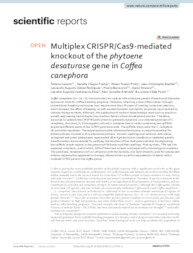Multiplex CRISPR/Cas9-mediated knockout of the phytoene desaturase gene in Coffea canéfora.
Multiplex CRISPR/Cas9-mediated knockout of the phytoene desaturase gene in Coffea canéfora.
Author(s): CASARIN, T.; FREITAS, N. C.; PINTO, R. T.; BREITLER, J. C.; RODRIGUES, L. A. Z.; MARRACCINI, P.; ETIENNE, H.; DINIZ, L. E. C.; ANDRADE, A. C.; PAIVA, L. V.
Summary: Coffea canephora (2n=2x22 chromosomes) is a species with extensive genetic diversity and desirable agronomic traits for coffee breeding programs. However, obtaining a new coffee cultivar through conventional breeding techniques may require more than 30 years of crossing cycles and selection, which hampers the effort of keeping up with market demands and rapidly proposing more resilient to climate change varieties. Although, the application of modern biotechnology tools such as precision genetic engineering technologies may enable a faster cultivar development process. Therefore, we aimed to validate the CRISPR/Cas9 system to generate mutations on a selected genotype of C. canephora, the clone 14. Embryogenic calli and a multiplex binary vector containing two sgRNAs targeting different exons of the CcPDS gene were used. The sgRNAs were under the C. canephora U6 promoter regulation. The target gene encodes phytoene desaturase, an enzyme essential for photosynthesis involved in B-carotene biosynthesis. Somatic seedlings and embryos with albino, variegated and green phenotypes regenerated after Agrobacterium tumefaciens-mediated genetic transformation were analyzed by verifying the insertion of the Cas9 gene and later by sequencing the sgRNAs target regions in the genome of Robusta modified seedlings. Among them, 77% had the expected mutations, and of which, 50% of them had at least one target with a homozygous mutation. The genotype, temperature of co-cultivation with the bacteria, and light intensity used for subsequent embryo regeneration appeared to strongly influence the successful regeneration of plants with a mutated CcPDS gene in the Coffea genus.
Publication year: 2022
Types of publication: Journal article
Unit: Embrapa Coffee
Observation
Some of Embrapa's publications are published as ePub files. To read them, use or download one of the following free software options to your computer or mobile device. Android: Google Play Books; IOS: iBooks; Windows and Linux: Calibre.
Access other publications
Access the Agricultural Research Database (BDPA) to consult Embrapa's full library collection and records.
Visit Embrapa Bookstore to purchase books and other publications sold by Embrapa.

